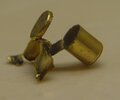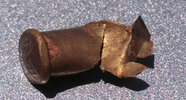I find the crimp very pronounced in a fired case. I would check case length and if the case head may have been past the chamber.
I noticed that, too. I have no explanation for that. Normally that mouth edge is opened up to allow the heel of the bullet out of the case.
My first thought was also the wrong cylinder, but OP states that was not possible.
My second thought was two bullets (or junk) somehow crammed into the case (typical of monday morning startup problems in almost any production environment) but that does not explain the lack of the crimp opening up. the excessive pressure might crack just the back of a faulty case.
Out of curiosity, have you fired many shorts out of that cylinder? I see the faint possibility that the chamber is just dirty enough up front to hold a faulty case / load together, but the clean back part open enough to let the brass go.
The crack continuing along the head is probably because once a crack starts, it tends to continue. That's why they drill stress relief holes at the ends of cracks to keep them from going any further:
Other advice above was to (A) not shoot any more of that lot and (B) send the case (or photo) and lot number to Winchester. Do this regardless of any hope of a response or free ammo. After all, the ammo is several years old, You might also check recall notices for the ammo
It could just simply be a matter of it happening every 7,894,384,629th .22 round they make.
Terry, 230N
REFs
See
Hatcher, p.233,
Hatcher, p.207









